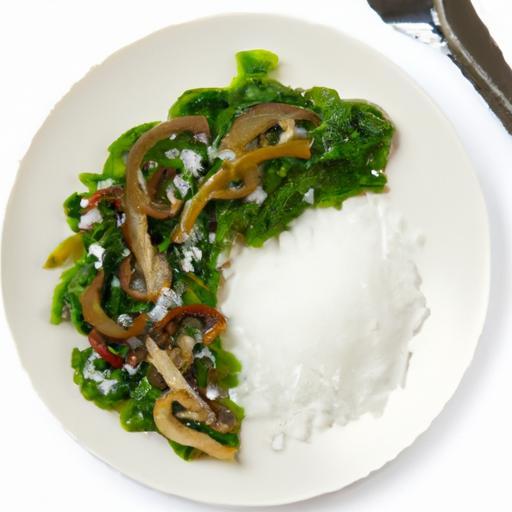In the vast universe of flavor enhancers, two contenders continually vie for our attention at the dinner table: MSG and table salt. Both deliver that essential element-sodium-that ignites our taste buds and elevates culinary creations, yet they do so in strikingly different ways. Welcome to the sodium showdown, where science, culture, and cuisine collide to unravel the mysteries behind these kitchen staples. Whether you’re a seasoned chef or a curious foodie, understanding the subtle dance between MSG and table salt can transform not only how you season your food but how you perceive the very essence of taste itself. Let’s dive into this savory saga and unpack the true power of sodium in our daily dishes.
MSG vs. Table Salt: Unpacking the Sodium Showdown brings us to a culinary crossroads where chemistry meets flavor. Whether you’re seasoning a hearty stew or elevating simple roasted vegetables, understanding the distinct roles of MSG (monosodium glutamate) and traditional table salt can revolutionize your cooking. This recipe-inspired exploration unlocks their unique chemical profiles and flavor impacts, helping you craft meals that are both delicious and mindful of sodium intake.
Prep and Cook Time
Prep: 10 minutes | Cook: 25 minutes | Total: 35 minutes
Yield
4 servings
Difficulty Level
Easy to Medium
Ingredients
- 1 lb boneless chicken thighs, cut into bite-size pieces
- 1 tbsp vegetable oil
- 1 medium onion, finely chopped
- 3 cloves garlic, minced
- 1 tsp ginger, freshly grated
- 1 cup diced bell peppers (red, yellow, or green)
- 1 tbsp soy sauce, low sodium preferred
- ½ tsp table salt (adjust to taste)
- ¼ tsp MSG (optional, for umami boost)
- ½ tsp freshly ground black pepper
- 2 tbsp chicken broth or water
- 2 green onions, sliced for garnish
- 1 tsp toasted sesame seeds, for garnish (optional)
Instructions
- Heat the oil in a large skillet over medium-high heat. Add the chopped onions and sauté until translucent and fragrant, about 3 minutes.
- Stir in garlic and ginger, cooking for an additional 1 minute to release their aromas without burning.
- Add the chicken pieces, spreading them evenly in the pan. Sauté until golden brown on all sides, about 6-8 minutes.
- Tip: Resist overcrowding the pan to ensure even browning. Cook in batches if needed.
- Toss in the diced bell peppers and sauté for 3 minutes to retain a slight crunch and vibrant color.
- Pour in the soy sauce and chicken broth. Stir well to combine and bring to a simmer.
- Season with table salt and, if desired, a pinch of MSG to enhance depth without overwhelming the dish.
- Cook for another 5 minutes, allowing flavors to meld and the sauce to thicken slightly.
- Finish with freshly ground black pepper and remove from heat.
- Garnish with sliced green onions and toasted sesame seeds just before serving.
Chef’s Notes
- MSG vs. Table Salt: Combining a modest amount of MSG with reduced table salt maximizes flavor while controlling sodium intake. MSG adds an umami richness that salt alone can’t achieve.
- Substitution tip: For a vegan version, substitute chicken thighs with firm tofu and use vegetable broth instead of chicken broth.
- Make-ahead: This dish reheats beautifully; store in an airtight container and reheat gently to maintain moisture and texture.
- Alternative seasoning: Experiment with a dash of smoked paprika or chili flakes for a smoky or spicy twist.
Serving Suggestions
Serve this flavorful chicken stir-fry over fluffy steamed jasmine rice or a bed of quinoa for a wholesome meal. A side of lightly sautéed greens, such as bok choy or spinach, complements the umami punch perfectly. Garnish extravagantly with fresh herbs like cilantro or basil to brighten the plate and add freshness.
| Nutrient | Per Serving |
|---|---|
| Calories | 280 kcal |
| Protein | 32 g |
| Carbohydrates | 8 g |
| Fat | 12 g |
Discover more about boosting umami in your dishes with natural ingredients.
For detailed health insights on sodium and MSG, the U.S. FDA offers comprehensive guidance on safe consumption and regulatory status.

Q&A
Q&A: MSG vs. Table Salt – Unpacking the Sodium Showdown
Q1: What exactly is MSG, and how does it differ from table salt?
A: MSG, or monosodium glutamate, is a flavor enhancer made from glutamate, a naturally occurring amino acid, combined with sodium. Table salt, on the other hand, is primarily sodium chloride-just sodium and chloride ions. While both contain sodium, MSG brings the umami taste to the table, adding depth and savoriness beyond the simple saltiness of table salt.
Q2: How do their sodium contents compare? Should I be worried about MSG’s sodium?
A: Interestingly, MSG actually contains less sodium per gram than table salt-about 12% sodium versus roughly 39% in table salt. This means that to achieve the same umami boost, you can often use less sodium overall with MSG, making it a clever ally in sodium reduction efforts.
Q3: Is MSG safe to consume, or does it come with health risks?
A: Despite decades of myths labeling MSG as a health villain, scientific research consistently shows MSG is safe for the general population when consumed in normal amounts. The so-called “Chinese Restaurant Syndrome” symptoms lack solid evidence, and regulatory agencies worldwide have deemed MSG safe. Like anything, moderation is key.
Q4: Can MSG replace salt in my cooking?
A: MSG isn’t a 1:1 salt substitute because it doesn’t provide the pure salty taste table salt does. Instead, it enhances existing flavors and adds that elusive umami richness. Many chefs use a combination-reducing salt and adding MSG-to create a balanced, flavorful dish with less overall sodium.
Q5: Why does MSG have a reputation for being “unnatural” or “processed”?
A: MSG is often misunderstood because it’s produced through fermentation of natural ingredients like sugar beets or molasses, similar to how yogurt or vinegar is made. It’s a bit of a food science twist on a natural amino acid rather than a synthetic additive. Its “processed” label is more about manufacturing than being artificial or harmful.
Q6: How does MSG affect flavor perception compared to salt?
A: MSG adds the fifth taste-umami-which is a savory, mouth-filling sensation that enhances meatiness, brothiness, and depth. Salt primarily enhances saltiness and can suppress bitterness. Together, they create a symphony of taste that can make dishes more complex and satisfying.
Q7: Should people with hypertension avoid MSG just like salt?
A: Since MSG contains less sodium, using it in moderation may help reduce total sodium intake, which benefits blood pressure control. However, people sensitive to sodium should still be mindful of all sources. Consulting a healthcare provider for personalized advice is always a good move.
Q8: What’s the verdict? MSG or table salt – which is the better seasoning?
A: The showdown isn’t about winners or losers but about complementary roles. Table salt brings essential saltiness, while MSG contributes savory umami and can help cut down overall sodium. When used wisely together, they can elevate flavors and support a healthier diet.
By unpacking the nuances of sodium and flavor, it’s clear that MSG and table salt each have unique powers-your taste buds (and body) will thank you for knowing when and how to use them!
To Wrap It Up
As we peel back the layers of the sodium saga, it’s clear that both MSG and table salt hold distinct places on our seasoning spectrum. Whether you reach for the crystalline granules of salt or the umami-packed spark of MSG, understanding their unique roles empowers you to craft flavors with intention and care. So next time you sprinkle or shake, remember: it’s not just about sodium content, but the subtle symphony each brings to your palate. In this flavorful showdown, knowledge is your secret ingredient-use it wisely, and let your taste buds be the ultimate judge.


